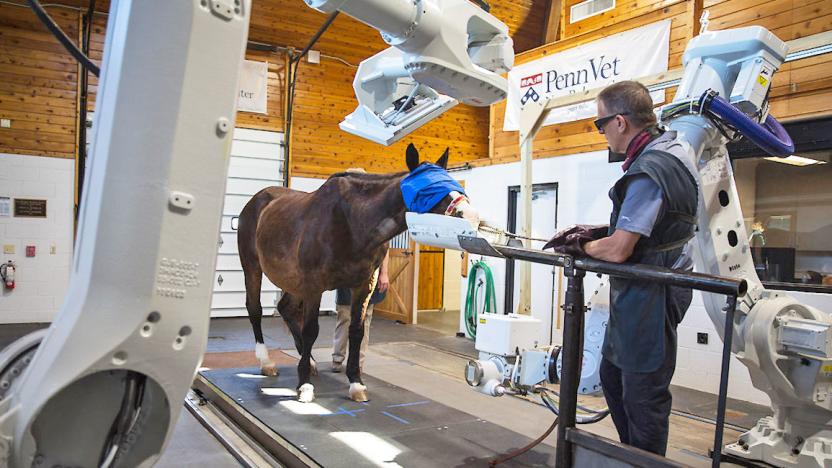VeterinaryMedicine
Latest

ICYMI: Robot running buddy, mechanical sea life and more
#fivemin-widget-blogsmith-image-97080{display:none;} .cke_show_borders #fivemin-widget-blogsmith-image-97080, #postcontentcontainer #fivemin-widget-blogsmith-image-97080{width:570px;display:block;} try{document.getElementById("fivemin-widget-blogsmith-image-97080").style.display="none";}catch(e){}Today on In Case You Missed It: A horse-sized, standing CT scanner has been invented to keep your equine pals from being tranquilized before images are taken; a sea urchin mouth was used as inspiration for a robot that could be sent to Mars to collect samples; and NASA engineers and MIT students created a robot for Puma that can be programmed to 'race' training runners. If you're less of a runner, more of an observer, the Kung Fu art of Tobias Gremmier may be more your speed. As always, please share any great tech or science videos you find by using the #ICYMI hashtag on Twitter for @mskerryd.

Equine CT scanner can peek inside standing, conscious horses
Horses are majestic creatures, but one thing they are not is tiny. Well, not for long, anyway. That creates a problem for equine medicine. When an animal weighs just under an imperial ton and is six-foot tall at the shoulders, there's only so much a veterinarian can do while the animal is still conscious. To that end, the University of Pennsylvania School of Veterinary Medicine (phew) is partnering with imaging outfit 4DDI to make free-standing CT scans a reality. Dubbed "Equimagine," the setup uses a pair of robotic arms that can gather internal images of a horse while it's awake and standing on all fours.

Whistle: the internet of everything goes to the dogs
One key part of our "internet of things" that seems to be capturing the imagination of a lot of people is the ability to track our activity and other health factors. It's not surprising to get with a group of people these days and see a Fitbit or Nike FuelBand on the waist or wrist of half the people in the room. Today, San Francisco-based Whistle announced pre-orders for its first product, a US$99.95 health tracker for dogs that is expected to ship this summer. A few weeks ago, I had the pleasure of chatting with Ben Jacobs, CEO and co-founder of Whistle. Jacobs noted that the cost of veterinary care over a pet's life exceeds $10,000, yet there's surprisingly little information that pet owners can supply to a vet about an ailing animal, and dogs certainly can't tell a vet what's wrong. Enter Whistle -- the namesake device is a small, metal, wireless on-collar monitor for dogs that collects data passively throughout the day that is then categorized as active, walk, resting or play. By monitoring information for a few months via an iPhone app (Android is planned for later), a baseline of the animal's activities is created. Deviations to that baseline are often indicative of health situations with a dog. In the wild, animals hide pain and injury in order to keep from becoming prey. That same instinct is present in house pets when they're not feeling well, and it's often difficult to see that a dog is in pain when you're at work most of the day. By tracking information over time, Jacobs notes that owners can see if it is their behavior -- for example, not being able to walk the dog on a regular schedule -- that is upsetting the baseline, or if it is a sign that the dog may be in pain. When you take your dog to the vet, he or she will be able to pull up reports showing the dog's activity over time. Whistle intends to accumulate data from all dogs wearing the devices so that they can create overall norms for different breeds and ages. If it sounds like Whistle is using this data to conduct canine health studies, you're absolutely correct. Jacobs noted that Whistle is working with the University of Pennsylvania's well-known Veterinary Clinic Investigations Center and other academic institutions to analyze the data. The company also has an advisory council made up of vets from around the country ranging from private general practitioners to veterinary cardiologists. The device will connect via both Bluetooth and WiFi to collect data, making it possible to connect both inside and outside the home. Jacobs mentioned that the device and apps will also allow different parties to indicate when they played with the dog, took it for a walk and more -- important when sharing the responsibility of a canine companion. We're hoping to get a Whistle later this summer for a full paws-on review; in the meantime, check out the intro video below and consider pre-ordering one for your four-legged friend.


